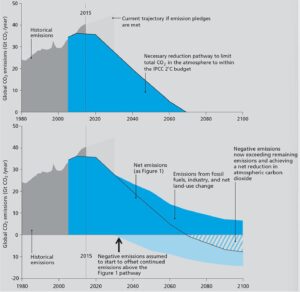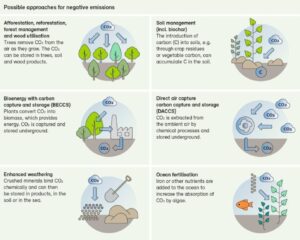Robin Hüppi (Theme 3)
Even if you know little about climate change, you are aware that too little is being done to save our climate. In this blogpost negative CO2 emissions and their most promising technologies are being described.
The world today is on average 1.1 degrees warmer that it was in 1850. If this trend continuous it will be 2 -3 degrees warmer by the end of this century according to the intergovernmental panel on climate change (IPCC, 2020). The main reason for the rising temperature is the increasing level of CO2 in the atmosphere. This is often directly related to the burning of coal, oil and gas – fossil fuels. Even if they actually stored CO2 it gets released when these fuels are burned. There are other contributing factors like agriculture and slash-and-burn land clearing techniques. In 2015 the world came together to sign the “Paris Climate Agreement (PCA)” which set the goal of limiting global temperature rise below 2 degrees, better 1.5 if possible. The PCA limits the amount of CO2 that can be released into the atmosphere. (dw.com, 2022)

Figure 1: Global emissions with/without negative emissions (arstechnica.com, 2022)
According to the lates IPPC’s report there are new scenarios for the requirements to counteract the climate change. The central role of the new requirements is a consequence of previous failures in global climate protection. (arstechnica.com, 2022) These new scenarios for mitigating emissions, whether more or less optimistic, have one thing in common that is probably new to most people. These scenarios include negative emission technologies with which it is possible to remove CO2 from the atmosphere. So-called negative emissions. The lower part of the Figure 1 shows the course of CO2 emissions, with continuous reduction and the use of negative emission technologies. The upper part shows how much faster emissions would have to be reduced if they could not be compensated. This makes clear that the implementation of negative emissions could at least give us back some of the wasted time. The question now is, what are negative emissions technologies? There are six possible approaches, as show in Figure 2. The three most significant and feasible ones are discussed below.

Figure 2: Possible approaches for negative emissions (bafu.admin.ch, 2022)
1. Afforestation, reforestation, forest management and wood utilization For a long time now, more trees have been felled than subsequently replanted.
As a result, the world’s forest areas are becoming smaller and smaller. This trend is particularly noticeable in the Southern Hemisphere. Therefore it is of great importance that more trees are planted again. According to studies from “a plant for the planet”, the world’s forests would have the potential to save 10% of current C02 emissions. The problem is that forests need space. For the mentioned potential to be reached, an area of the USA would have to be afforested with trees. Nevertheless, planting trees is a relatively simple and inexpensive way to remove C02 from the atmosphere. It is estimated to cost $20 to offset one ton of C02. (bbc.com, 2022) A good example is “a plant for the planet”. According to their own information, there are currently 3,000 billion trees growing in the world and there is room for another 1,000 billion. With their homepage anyone has the opportunity to launch your own reforestation projects anywhere in the world. The homepage serves to transparently follow the current projects and motivate the public to invest money in local or international projects. On one Page the contemporary progress of 1.000 billion tree’s is visible. (a.plant-for-the-planet.org, 2022)
2. Bioenergy with carbon capture and storage (BECCS)
BECCS is a carbon removal, where Biomass (organic material) is converted into heat, electricity, or liquid or gas fuels (step one). The carbon emissions from this conversion are captured and stored in geological formations or even embedded in long-lasting products (step two). The key is that biomass draws carbon form the atmosphere during its growing process, BECCS is an negative emission technology when it is implemented well. While the first step of BECCS, bioenergy and biofuels are widely used, the other component for BECCS is well understood, but for economical reasons it has mostly struggled in the past. Although there are some concerns along the technology the potential of scale and costs are auspicious but widely spread. The cost estimates reach from 20$ to 200$. (american.edu, 2022)
3. Direct air capture carbon and storage (DACCS)
According to the goals of the PCA, this technology plays a key role to meet those, because of its simplicity. Unlike other carbon removal technologies that capture emissions during the process of generation electricity or heat like BECCS is doing it, DACCS can be deployed anywhere in the world with access to a supply of electricity. The easiest way to describe DACCS is as a form of industrial photosynthesis. Like plant use photosynthesis to convert sunlight and CO2 into sugar, DACCS uses electricity to remove CO2 from the atmosphere using fans and filters. The procedure begins by aspiring air trough industrial fans into the system. From there on two different techniques exist. First one removes CO2 by passing the air trough a chemical solution and returns the rest of the air back to the atmosphere. The second one captures CO2 on the surface of a filter converted in a chemical agent, where it then forms a compound. The new compound is heated and realizes the CO2 which then can be separated from the chemical agent. The captured C02 from both techniques can then be compressed and injected into deep geological formations.
At the moment there are 15 DACS plants in operation. Climeworks – spin-off from ETH Zürich – is one of them. Their biggest plant is developed in Iceland. Because the concentration of CO2 in the air is very dilute which also causes high consumption of electricity, storing CO2 with DACCS becomes very difficult. Thus DACCS costs significantly more that other negative emissions technologies. The costs are estimated between $200 and $600 per tonne of CO2. (drax.com, 2022)
To conclude, on the one hand, there is increasing recognition of the need for the mentioned technologies; on the other, there is a risk that their potential may be overestimated. Furthermore many fundamental issues, such as costs or conflicting objectives, have not yet been explored sufficient. Meaning that the implementation of these technologies is far from clear. Therefore negative emission technologies are no alternative to immediate and massive reduction of CO2 pollution. (bafu.admin.ch, 2022)
References
a.plant-for-the-planet.org. (2022).
american.edu. (2022). fact sheet bioenergy with carbon capture and storage. arstechnica.com. (2022). carbon dioxide removal tech is behind schedule. bafu.admin.ch. (2022). negative emissions technologies.
bbc.com. (2022). science environment.
drax.com. (2022). what is direct air carbon and storage dacs. dw.com. (2022). carbon capture paris agreement co2 emissions.